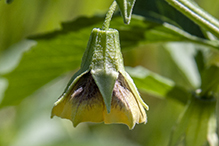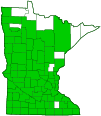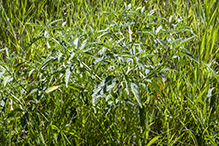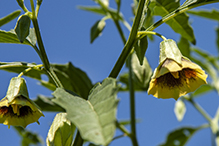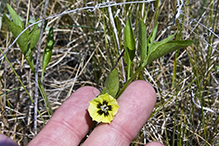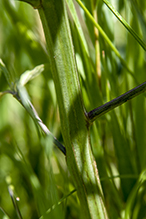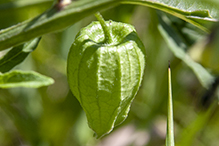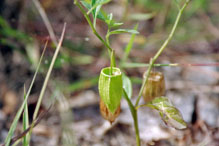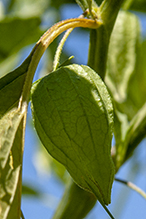Virginia groundcherry
(Physalis virginiana var. virginiana)
Conservation • Description • Habitat • Ecology • Use • Distribution • Taxonomy
Conservation Status |
|
|||||||
| IUCN Red List | not listed |
|||||||
| NatureServe | N5? - Secure SNR - Unranked |
|||||||
| Minnesota | not listed |
|||||||
Description |
||
Virginia groundcherry is a 12″ to 24″ tall, erect, perennial forb that rises from a deep, horizontal, tough rhizome. It often forms colonies. The stems are forked with ascending branches. The upper part of the stems are covered with short, stiff hairs that are bent backward, and no glandular hairs. The leaves are alternate, thick, soft to the touch, stalked, egg-shaped to narrowly lance-shaped, 1¼″ to 3″ long, and 1½″ to 2½″ wide. They are broad and rounded or heart-shaped at the base, and taper to a point at the tip with straight sides along the tip. The margins have a few irregular teeth. The upper and lower surfaces have silky, appressed hairs as well as glandular hairs. The inflorescence is single flowers nodding at the end of ⅜″ to ¾″ long, hairy stalks (pedicels) rising from the leaf axils. The flowers are ½″ to ¾″ long and wide. There are 5 pale yellow petals with purple to brown splotches near the center. They are fused into a bell-shaped corolla with 5 shallow lobes. The fruit is a ½″ spherical, berry, green at first, turning orange at maturity. It is enclosed in an inflated, papery, heart-shaped, 5-angled, ¾″ long husk. The tip of the husk is mostly closed, and the base is sunken. The husk hangs from a ⅜″ to ¾″ long pedicel. The berries are poisonous when green, edible when ripe. |
||
Height |
||
12″ to 24″ |
||
Flower Color |
||
Pale yellow with purple to brown centers |
||
Similar Species |
||
Clammy groundcherry (Physalis heterophylla) is a taller plant, up to 36″ at maturity. The upper stems are covered with both long, soft, shaggy hairs and sticky, glandular hairs. The leaves are broad, rounded or heart-shaped at the base,and clammy to the touch. The fruit is an yellow berry. The base of the husk is indented (this may be difficult to distinguish from the sunken base of Virginia groundcherry). |
||
Habitat |
||
Dry. Prairies, upland woods, fields. |
||
Ecology |
||
Flowering |
||
July to August |
||
Pests and Diseases |
||
|
||
Use |
||
|
||
Distribution |
||||
|
Sources |
|||
| 3/24/2023 | ||||
Nativity |
||||
Native |
||||
Occurrence |
||||
|
||||
Taxonomy |
|||
| Kingdom | Plantae (Plants) | ||
| Division | Tracheophyta (Vascular Plants) | ||
| Subdivision | Spermatophytina (Seed Plants) | ||
| Class | Magnoliopsida (Dicots) | ||
Order |
Solanales (nightshades, bindweeds, gooseweeds, and allies) | ||
Family |
Solanaceae (nightshade) | ||
| Subfamily | Solanoideae (nightshades and allies) | ||
| Tribe | Physaleae (groundcherries, lanterns, and allies) | ||
| Subtribe | Physalinae | ||
Genus |
Physalis (groundcherries) | ||
| Species | Physalis virginiana (Virginia groundcherry) | ||
Subordinate Taxa |
|||
|
|||
Synonyms |
|||
Physalis intermedia Physalis lanceolata Physalis monticola |
|||
Common Names |
|||
field groundcherry lance-leaved ground-cherry lanceleaf groundcherry obedient plant Virginia ground cherry Virginia ground-cherry Virginia groundcherry |
|||
Glossary
Corolla
A collective name for all of the petals of a flower.
Glandular hairs
Hairs spread over aerial vegetation that secrete essential oils. The oils act to protect against herbivores and pathogens or, when on a flower part, attract pollinators. The hairs have a sticky or oily feel.
Pedicel
On plants: the stalk of a single flower in a cluster of flowers. On insects: the second segment of the antennae. On Hymenoptera and Araneae: the narrow stalk connecting the thorax to the abdomen: the preferred term is petiole.
Rhizome
A horizontal, usually underground stem. It serves as a reproductive structure, producing roots below and shoots above at the nodes.

Slideshows |
||

Visitor Videos |
|||
Share your video of this plant. |
|||
| This button not working for you? Simply email us at info@MinnesotaSeasons.com. Attach a video, a YouTube link, or a cloud storage link. |
|||
Other Videos |
|||
| Weed of the Week #841 - Virginia Groundcherry (Air Date 5/18/14) AgPhD's channel |
|||
About
Published on May 21, 2014 It's our Weed of the Week, Virginia Groundcherry. |
|||

Visitor Sightings |
|||||
Report a sighting of this plant. |
|||||
| This button not working for you? Simply email us at info@MinnesotaSeasons.com. Be sure to include a location. |
|||||
|
|||||
MinnesotaSeasons.com Sightings |
|||||
Blazing Star Prairie Addition Preserve, South Unit Carpenter St. Croix Valley Nature Center Felton Prairie SNA, Bicentennial Unit Kellogg Weaver Dunes SNA, Weaver Dunes Unit Mound Spring Prairie SNA, North Unit Mound Spring Prairie SNA, South Unit Northern Tallgrass Prairie NWR, Hoffman Unit Northern Tallgrass Prairie NWR, Touch the Sky Prairie Unit Sand Prairie Wildlife Management and Environmental Education Area |
|||||

Created 10/17/2004
Last Updated:
